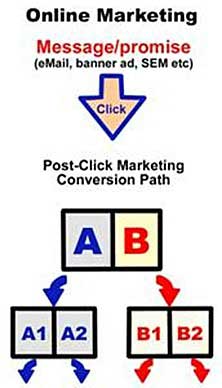Because they are flexible and targeted, conversion paths allow you to segment, qualify, and convert your online respondents from paid search, display ads, email, and other sources of paid and unpaid Web traffic.
Let's kick off the anatomy lesson by defining what we mean by "conversion path."
A conversion path is a conversion-focused, linear landing experience, specifically designed to catch and convert incoming traffic from your online marketing campaigns.
Conversion paths live outside of the structure of a company's main site and are typically used in place of landing pages, microsites, or deep links; their intent is to improve conversion rates, lead quality, and overall marketing intelligence related to your respondents and traffic sources.
Conversion paths move respondents from landing through conversion by using branching experiences. Conversion paths comprise a series of connected pages that accomplish the following:
- Segmentation
- Offer or pitch
- Thank you
The following image shows a simple conversion path flow of landing pages, where segmentation is represented by A and B, and sub-segmentation represented by A1/A2 and B1/B2.

It All Starts With Segmentation
A conversion path always starts with a segmentation page—the page that respondents land on when they click through from an online ad. The page should be utterly simple, with just a couple of choices. This page will take the somewhat anonymous respondents from paid media and segment them based on who they are or what they're looking for.
For example, let's say we are marketing a high-end Caribbean resort via Google. After users click on our text ad and land on our conversion path, our first mission is to target the right content to each respondent. We know they are interested in our resort, but are they interested in vacationing with children? Water sports? A destination wedding? A honeymoon? In this example, we might present two segmentation choices—romantic rendezvous or family vacation—so users can learn about the resort based on their interests.
Of course, we could offer more than two options to respondents—say, golf, boating, or diving—but it's important that the segmentation page be simple, focused, and clear.
Now that we're pitching our resort to the user's interest, we could segment one step further if needed. Say we have an initial "Island Wedding" segmentation. We can then sub-segment wedding respondents based on whether they want to work with a staff wedding planner or plan the wedding themselves.
The key to segmentation and sub-segmentation is that each click pays off with a page relevant to the respondent. The bride who wants to plan her own island wedding should be directed to a page different from that of the bride who wants the help of the resort wedding planner.
Rather than having respondents randomly surf a site and find the information themselves, or assuming that a single page to appeal to everyone, a conversion path makes it easy to serve up truly relevant content to your audience.
What We Learn From Segmentation
To the marketing manager running the campaign, the tracking of these segmentation choices—aside from targeting the right content to the right respondent, which naturally improves conversion rates—reveals who's responding to which ads, even if they don't convert.
The result is insight into segments and conversions, so that instead of trying to globally optimize a marketing campaign for all, we can maximize each audience segment independently.
What Do You Have to Offer?
Make it compelling and make it clear—because now's your chance to get the conversion.
Now that we're pitching our resort based on the user's very specific interest—whether the family vacation of a lifetime or the bride's big day—we can tailor the offer accordingly and provide highly relevant and compelling information to help generate a conversion.
Every offer page will be different, and every company will have a different idea of what a "conversion" means. For our resort, it could be an online booking or it might be as simple as a completed contact form exchanged for a vacation planner filled with local excursions and offers.
So, at the point of conversion, we ask for the conversion only after we have given them relevant information. And as a result, we get a higher conversion rate than we otherwise would have.
What We Learn From the Offer
By segmenting our users according to their interests, we can apply highly relevant A/B tests for offers or fulfillments that enable us to quickly determine what works best. Again, by not trying to globally optimize our offer, we can really maximize the potential from each audience segment.
Mind Your Manners and Always Say Thank You
Whether respondents have booked a vacation or just supplied contact details to receive their vacation planner, you should always thank them for the exchange—in a way that deepens engagement and builds the relationship even further.
The thank-you page of our conversion path is our final opportunity to provide users with content that relates to their conversion. This is where we can introduce all the information that, had it been included elsewhere, would have distracted the user from the ultimate goal: conversion.
Here we can deep-link into a photo gallery that lives in our website, link to a customer feedback blog, or serve up additional offers to further engage our user. The point is to do these things only after we have achieved the conversion.
What We Learn From the Thank You
Saying thank you is not only the polite thing to do but also a great opportunity to test offers or content.
By including various links to resources after the conversion, we can gauge user interest without jeopardizing our campaign goals. If there is overwhelming user interest in a resource offered on the thank-you page, you might well have identified an upcoming promotion or a vehicle for cross-promotion.
Keeping resources rich and tracking clicks helps uncover even more knowledge about respondents.




